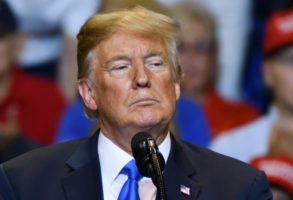
Published May 23, 2018
Since Donald J. Trump entered the presidential race in June 2015, commentators have wondered whether he is mentally ill, brilliant, or both. Scott Adams, in his new book, Win Bigly: Persuasion in a World Where Facts Don’t Matter, forcefully argues for Trump’s brilliance. Trump is proficient in the art of political persuasion; what looks crazy is in fact the work of a “Master Persuader.”
Win Bigly is an eccentric book, partly a museum of psychological qualities, partly a tactical manual about persuasion, partly the story of Trump’s 2016 electoral victory, and partly Adams’s own story, which includes predicting Trump’s victory over a year before the election. Through its demonstration that Trump is a Master Persuader, it raises the question whether Trump’s persuasion of the American electorate is simply cheap-trick manipulation, or one of the finest performances of its kind since the founding.
Adams, the creator of the much-admired Dilbert comic strip, began life as an upstate New York kid with modest means. He is now a highly successful, self-employed author living in northern California, the author of books about persuasion and professional success, and one of the most sought-after public speakers in America. He is an extraordinarily independent and unique person.
Similar to other business writers, like Tony Robbins or David Allen, Adams seems immune to party affiliations or associations that wed him to positions he has not come to on his own. The personal stories he tells exemplify a high degree of pragmatism mixed with fierce independence. It’s no surprise he’s built a highly successful business based on a product of art and imagination.
If you’re thinking that this reminds of Trump, you’re right. Not only have Adams and Trump both built businesses, they have both spent considerable time writing business books. Most importantly, both have spent time thinking about and practicing the arts of persuasion. This puts Adams in an excellent position to assess Trump’s persuasive qualities.
Adams thinks Trump “the most persuasive human [Adams has] ever observed.” Indeed, Adams saw early that Trump was not the clown he was widely accused of being but was instead “using high-end business strategy” in his communication and persuasion tactics. This strategy did not require correct policy positions or factual arguments. Instead, Trump relied on visual persuasion and “deeply engineered” nicknames, creating opportunities for the electorate to imagine him as president.
Consider Trump’s nicknames for campaign opponents: Lyin’ Ted, Low-energy Jeb, Lil’ Marco, and Crooked Hillary. Not only were the adjectives ascribed to opponents “uncommon in political campaigns”―therefore sticking in the minds of voters―they were also “visually compatible with the person he was branding.” For instance, voters saw Clinton’s eyes crossed in many photos and knew that allegations of corruption swirled round her. Most importantly, “Trump’s nicknames anticipated future confirmation bias to make them stickier and more powerful over time.” It was inevitable that Senator Rubio would appear short in pictures, which would remind observers of Trump’s nickname. And Senator Cruz would eventually say something “that the fact-checkers would flag, because all politicians do.” Observers would see this as confirmation of Trump’s nickname.
Trump’s use of visual imagery was equally persuasive. People, writes Adams, “automatically gravitate toward the future they are imagining most vividly, even if they don’t want the future they are seeing.” The Master Persuader, in the context of politics, is not the person who most effectively articulates arguments but the one who controls what people imagine the future of the country will look like.
Consider the immigration reform and border security debate during the Republican primary. Over and over, candidates referred back to the “Gang of Eight” proposal from 2013, or spoke about improved border security. Trump’s proposal―the big, beautiful wall―was more appealing because it was simpler. As Adams notes, “there is one kind of wall that is hard to criticize: the one that is entirely different in each person’s head.” Trump’s simplified image reached more people than his opponents’, whose good ideas “died on arrival.”
Aware that few Americans could imagine him as president when he announced his candidacy, Trump manufactured opportunities for voters to visualize him in the executive office, appearing, for example, on Saturday Night Live on a stage set up as the Oval Office. In contrast, Clinton appeared in an SNL skit as a bartender serving drinks to an inebriated Hillary Clinton character. Audiences were left with the image of Trump as president―even if the jokes were at his expense―and of Clinton as a drunk. Trump’s skit was strategic: he would not have appeared on SNL without approving the skit beforehand.
According to Adams, Trump possesses “weapons-grade” persuasion talent. Adams believes that Trump’s talent in persuasion is not natural but has been steadily developed over the course of his career. If Adams is right―and I have no reason think he’s not―then Trump’s 2016 victory is an example of persuasion perfectly engineered to the desires of the American electorate.
Reading Adams’ book might give readers the impression that such persuasion is both irrational and involuntary―a kind of trick. Was the American electorate duped by candidate Trump? Is Trumpian persuasion a departure from the American constitutional system or one of the best examples of persuasion in our political life?
The Constitution does not assume that the American people are completely reasonable all of the time. The people established and uphold the Constitution as the fundamental law of the land because of self-interest: security, the general welfare, peace, liberty, and justice. The constitutional order is based not on perfect reason but on self-interest.
One of America’s earliest examples of political persuasion is based on the assumption that men act according to their own interests, and that nothing is more certain than that political debate will be influenced by dark motives on both sides of any question. Persuading the people of New York to adopt the Constitution, Alexander Hamilton, in Federalist 1, wrote that, “[a]mbition, avarice, personal animosity, party opposition, and many other motives not more laudable than these, are apt to operate as well upon those who support as those who oppose the right side of a question.” Persuaders should not seek to make the most reasonable case, but the one that takes into account our various motives.
Republican politics depends on a candidate persuading voters that he is best for the job. This often requires reliance on appealing imagery and engaging voters’ imaginations, rather than arguments based solely on the merits of the case. Adams demonstrates not only that Trump strategically made his case to voters, but that he is a uniquely talented persuader. Reading Bigly will convince readers there is more to the president’s tweets than meets the eye and will spur them to consider the president’s actions and comments in the light of Adams’s “persuasion filter.”
Ian Lindquist is a visiting fellow at the Ethics and Public Policy Center.








